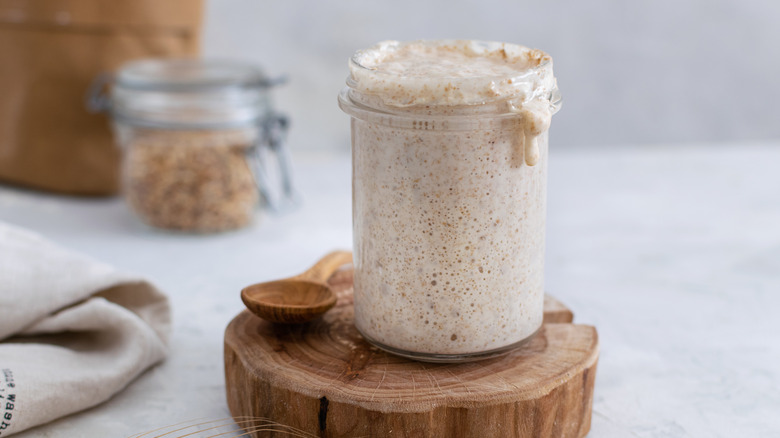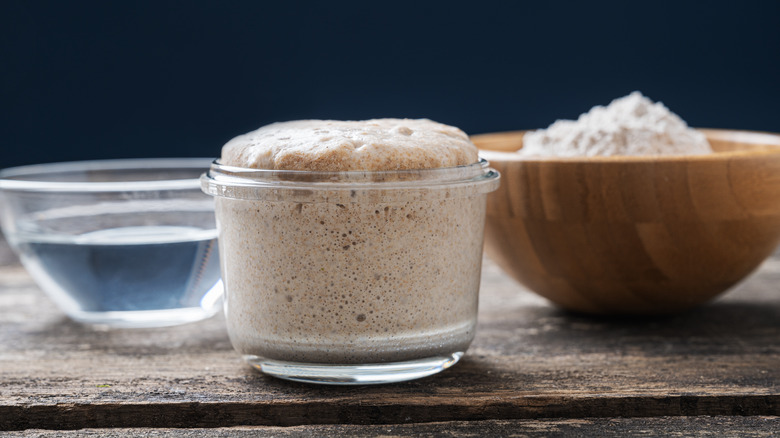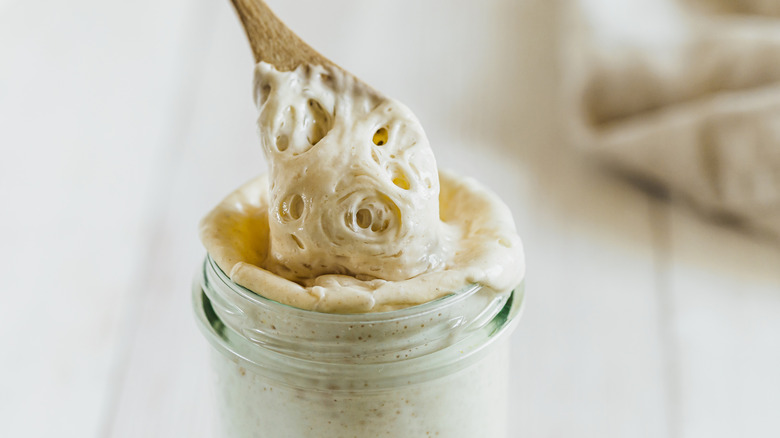The Trick To Reviving That Sourdough Starter That's Been In Your Fridge For Months
Refinery29 says that baking sourdough bread was one of the hottest trends when the COVID-19 Pandemic began in 2020. Countless people who suddenly had an abundance of time on their hands sought out no-knead sourdough bread recipes to help pass the days away. It's hard to say how many people stuck to this new hobby, but it certainly brought this humble bread back into the cultural spotlight.
Sourdough went from being an ancient baking method to the hot new thing that year. You Knead Sourdough points out that while we can't know sourdough's exact origins, we do have documentation that it existed in one of the oldest-known civilizations. Ancient Egyptians in 1500 B.C. used sourdough to create lifted bread with improved flavors. The Sourdough School claims that sourdough would remain the primary form of yeast in the baking world too until commercial yeasts were invented millennia later.
With their invention, sourdough baking fell out of fashion, and so many sourdough newbies might not know the essentials of sourdough care.
What is a sourdough starter?
Those who have never baked with sourdough, might not understand why sourdough care is even a necessity. Besides learning how to store dry yeast, there isn't much care needed for the more conventional leavening agents. As "Sourdough" author Robin Sloan told Electric Literature, having a sourdough starter is a little like using a "weird roommate as a kitchen ingredient." The reason for this odd description is that a sourdough starter requires a feeding schedule, and has its own moods based on its living conditions. The reason for this temperamental nature is that sourdough starters are living organisms.
Flour and water are mixed together, and left to sit out in the open and begin fermenting. Wild bacteria and yeast that are present in the flour and in the air are responsible for the fermentation as they feed on the sugars present in the starter. King Arthur Baking Company recommends feeding the starter with fresh flour and water twice a day until it has matured. You can then use the water test to check when it's ready to start baking.
In between bakes though, you'll likely want to store it in the fridge to make feedings less frequent. King Arthur Baking Company says you'll still need to feed it about once a week to keep it active, but what happens if you let it go for too long?
How to revive an old sourdough
If your sourdough has been sitting forgotten in the back of your refrigerator since 2020, it might be lost. If it's only been a few months though, and you were working with a pretty mature sourdough, then you might still have a fighting chance. Crave the Good claims that it was able to revive a sourdough starter that had been neglected for four months. This might not hold true for every starter, but certain ones might come back to life with a little TLC.
Crave the Good says that if your sourdough starter appears moldy, then it's best to throw it out. It can be hard to tell when something fermented has gone bad though. If it appears to be thick and chunky and smells musty or moldy, then it's got to go. If your sourdough starter is simply thin and watery, and still has an acidic, vinegary smell, then it's likely still safe to revive.
To revive a neglected starter, Crave the Good recommends letting it come to room temperature before mixing equal parts sourdough, water, and flour, and letting it sit out to ferment. Homesteading Family says that once you've revived your starter, give it another three or four days of regular feedings to help it reach maturity once again. From there, it should be safe to store in your refrigerator again, but try and remember it this time!


